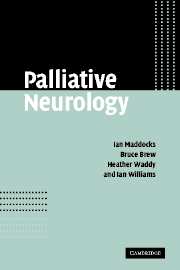Book contents
- Frontmatter
- Contents
- Foreword
- Note on drugs and abbreviations
- Section I Palliative Management
- Section II Major discomforts in advanced neurological illness
- Section III Major neurological conditions requiring palliation
- 1 Cerebrovascular disease: stroke
- 2 Demyelinating disease
- 3 Parkinson's disease and related disorders
- 4 Dementia
- 5 Amyotrophic lateral sclerosis (motor neurone disease)
- 6 Incurable Infections of the nervous system
- 7 Muscular dystrophy
- 8 Neuropathies
- 9 Huntington's disease
- 10 Cerebral neoplasms
- 11 Sequelae of traumatic brain injury
- Section IV Ethical issues
- Section V Appendices
- Index
7 - Muscular dystrophy
from Section III - Major neurological conditions requiring palliation
Published online by Cambridge University Press: 08 January 2010
- Frontmatter
- Contents
- Foreword
- Note on drugs and abbreviations
- Section I Palliative Management
- Section II Major discomforts in advanced neurological illness
- Section III Major neurological conditions requiring palliation
- 1 Cerebrovascular disease: stroke
- 2 Demyelinating disease
- 3 Parkinson's disease and related disorders
- 4 Dementia
- 5 Amyotrophic lateral sclerosis (motor neurone disease)
- 6 Incurable Infections of the nervous system
- 7 Muscular dystrophy
- 8 Neuropathies
- 9 Huntington's disease
- 10 Cerebral neoplasms
- 11 Sequelae of traumatic brain injury
- Section IV Ethical issues
- Section V Appendices
- Index
Summary
There are many variants of muscular dystrophy, most of them quite rare. The more common types go by names such as myotonic muscular dystrophy, facioscapulohumeral muscular dystrophy, myotonic dystrophy and duchenne muscular dystrophy (DMD) and have many similar features, primarily limb, trunk and neck weakness with impairment of mobility and respiration, but sometimes also cardiac abnormalities or cataract that will need other specialist opinion. DMD is chosen as the basis for this discussion. It is first diagnosed in childhood, when increasing difficulty is observed in running, getting up from the floor and walking up stairs. By the teenage years, many will be wheelchair bound, coping with repeated chest infections, dyspnoea and night hypoxia as ventilation becomes increasingly impaired. There may be concomitant cardiac failure and intellectual disability.
THE SUPPORTIVE PHASE OF CARE
The course of DMD will commonly extend for longer than a decade, and constitutes a major burden of care for a family, usually the mother. During this time there will be continuing efforts to encourage the fullest possible life in the face of progressive muscular weakness, calling upon the advice and assistance of many health professionals for hydrotherapy, physiotherapy, speech therapy, psychotherapy and provision of special equipment.
A discipline of regular passive stretching exercises to prevent contractures, supervision of prescribed periods of standing, fitting of night plasters or consideration of tendon lengthening procedures all make demands on family members, who often become very involved, feeling a responsibility for holding back the progress of the disease.
- Type
- Chapter
- Information
- Palliative Neurology , pp. 178 - 182Publisher: Cambridge University PressPrint publication year: 2005



